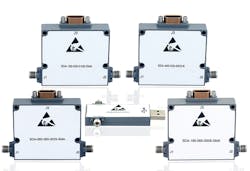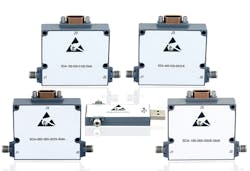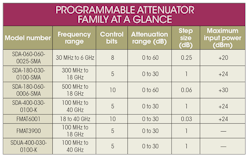Programmable Attenuators Step 30 MHz to 40 GHz
This file type includes high-resolution graphics and schematics when applicable.
Amplitude control over wide bandwidths is essential for many commercial and military applications, and system architects often rely on digitally controlled PIN-diode attenuators to do the job. Typical applications include benchtop and automated test equipment, fading simulators for multiple-input, multiple-output (MIMO) communications systems, radar, and electronic-warfare (EW) systems. To serve these requirements, Fairview Microwave recently launched a line of digitally programmable step attenuators that cover wide frequency ranges well into the millimeter-wave region with attenuation steps as small as 0.03 dB.
Collectively, the seven attenuator models cover frequencies from 30 MHz to 40 GHz with either 0- to 30- or 0- to 60-dB maximum attenuation range, TTL-controlled tuning resolution of 5, 8, or 10 b, and switching speeds between attenuation states of typically 1-µs on time and 0.5-µs off time for most models. With such performance parameters, these attenuators become particularly useful for the RF and intermediate-frequency (IF) sections of communications transceivers, as well as for level control in signal generators and other test equipment. The devices come with stainless-steel female SMA or 2.92-mm coaxial connectors, depending on frequency range.
An increasing trend in recent years, especially in automated and benchtop test environments, is use of the Universal Serial Bus (USB) as a source of power and control for variable attenuators. A USB connection to a personal computer (PC) can reduce the number of connections required in a system while eliminating the need for an external power supply. Two of the new attenuators, models FMAT3900 and SDUA-400-030-0100-K, use this approach with an integrated USB 2.0 interface and driverless installation, along with downloadable Windows-based control software. All other models are controllable and powered by a 15-pin Micro-D interface.
The USB-controlled model FMAT3900 covers 100 MHz to 18 GHz with attenuation range of 0 to 30 dB in 1-dB steps. Models SDUA-400-030-0100-K (USB) (see figure) and SDA-400-030-0100-K (Micro-D), which have the broadest frequency range among the family members, cover 100 MHz to 40 GHz with 0- to 30-dB attenuation range, 5-b resolution, and 1-dB step size. These attenuators are excellent choices for measurement applications, as they can serve almost any likely test scenario thanks to their broad frequency-range coverage (for more on attenuators, see “Getting a Grip on Variable Attenuators”).
Other features common to all of the attenuators include an operating temperature range of –50 to +85°C, small size of usually 2.25 × 1 × 0.33 in., typical VSWR of 2.50:1 or less, maximum input power-handling capability to +20 dBm, insertion loss of 4.5 to 8.0 dB, attenuation accuracy of ±1.3 to ±2.5 dB, and attenuation flatness of ±1.5 to ±3.0 dB. The table shows key specifications of all models for comparison.
Brian McCutcheon is Vice President of Fairview Microwave.
Fairview Microwave Inc., 1130 Junction Dr. #100, Allen, TX 75013; (800) 715-4396.
Looking for parts? Go to SourceESB.



